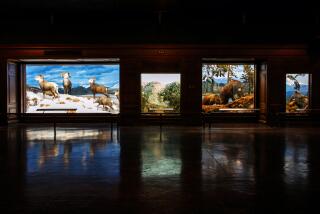ILLUSTRATOR MAKES PREHISTORY
- Share via
“My fascination with prehistoric animals began when I was about 4 years old, when my father bought me a book about dinosaurs,” explains illustrator Mark Hallet. “The black-and-white illustrations had an extremely photographic quality, and in my youthful naivete, I assumed the animals were still alive. I was terribly disappointed when my father gently told me they were extinct, but I was also intrigued.”
Thirty-five years later, Hallet continues to overcome that disappointment by bringing dinosaurs to life in extremely vivid paintings. His work is currently on display at the Natural History Museum of Los Angeles County as part of its popular “Dinosaurs Past and Present” exhibition. The exhibition, which will be on display through Aug. 31, will become the first major traveling exhibition in the museum’s 73-year-history.
In conjunction with “Dinosaurs Past and Present,” Hallet will conduct a teachers workshop at the museum today on principles of scientific illustration of dinosaurs.
A soft-spoken, articulate man, Hallet discussed his work and the special place dinosaurs occupy in the popular imagination during a recent interview at the museum, which is currently planning to give dinosaurs more space as part of its new expansion program.
“I think dinosaurs excite people for many different reasons,” he says. “They were often big and they were such strange creatures--unlike any living animals in many ways. And their inaccessibility adds to their fascination. We tend to take for granted many really equally fascinating animals because they’re with us today and we can go to the zoo and see them.”
New discoveries and theories have stimulated widespread interest in dinosaurs over the last 10 years, but Hallet complains, “Dinosaurs are cast in a very campy, sort of circusy light in the popular media--almost as if they weren’t real, and of course they were. Artists and anatomists like myself see them in our minds as very real animals, so we strive to create images that reflect the realism we see in our minds.”
Months of research go into each of Hallet’s paintings. He begins by consulting leading scientists and examining the skeletal remains of the animal. The skeleton reveals the animal’s basic anatomy and offers clues about its habits--such as the way it moved, what it ate. Scars and ridges on individual bones show where large muscles were attached.
But fossils can only provide a limited amount of information: No one knows what dinosaurs really looked like or what colors they were. To complete a restoration, Hallet must rely on a combination of imagination and knowledge of living animals.
“I usually attempt to base the coloration on what might be known about the animal’s habitat,” he says. “If the dinosaur lived in an open flood plain, you might expect it to have a disruptive coloration scheme that would break up its mass to help conceal it from predators--very much like zebras and giraffes today.
Besides his work as an illustrator, Hallet teaches zoological illustration at Otis Art Institute of Parsons School of Design in Los Angeles and is preparing a seminar on the subject for UC Irvine this summer. He has also designed and illustrated a series of children’s books on endangered animals. He sees an important link in his work between living and extinct animals.
“I hope the enthusiasm people show for prehistoric animals will make them mindful of the plight of many modern, living animals,” he concludes. “Many of these creatures are literally on their way out unless we do something about them. Within our generation, we’ll see many of these animals either preserved on our planet or joining the dinosaurs in extinction.”
More to Read
The biggest entertainment stories
Get our big stories about Hollywood, film, television, music, arts, culture and more right in your inbox as soon as they publish.
You may occasionally receive promotional content from the Los Angeles Times.










